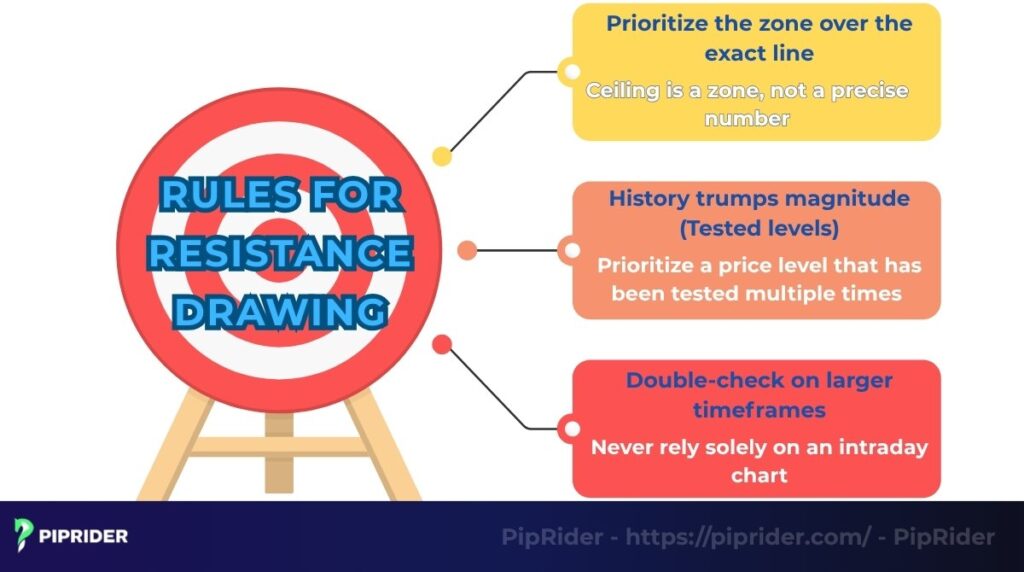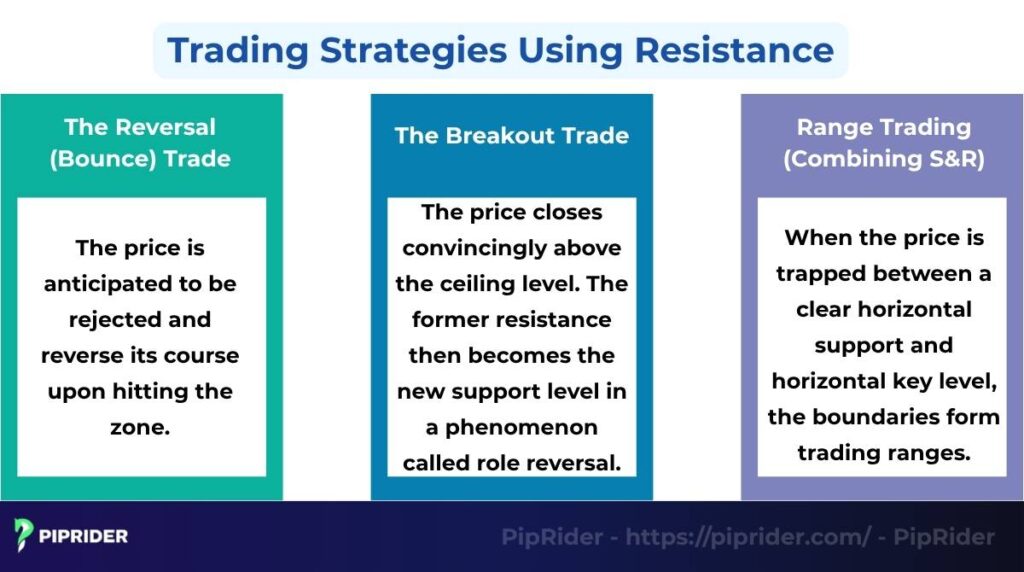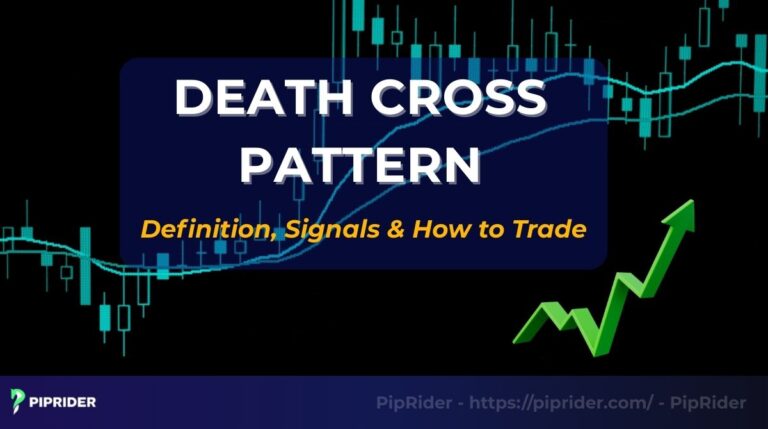Resistance drawing is one of the most vital skill in technical analysis. It is the process of plotting the specific price level, where selling pressure is historically strong enough to halt or reverse an asset’s upward trend. For any trader serious about maximizing returns and managing risk, mastering how to draw correctly is non-negotiable.
This guide provides the objective, actionable steps for precise support and resistance charting. PipRider will show you how to identify strong price levels that professionals rely on, helping you move from price guesswork to trading with certainty on any market.
Key Takeaways
- Resistance is the supply zone where sellers overwhelm buyers, halting the uptrend.
- Draw resistance by connecting two or more significant pivot highs (extreme price points).
- Strong resistance levels are validated by multiple touches, high volume, and higher timeframes (Daily/Weekly).
- A break triggers a role reversal, turning the former resistance level into new support.
- Use a resistance zone (not a single line) to filter out volatility and false breakouts.
1. What Are Support and Resistance Levels?
Support and Resistance (S&R) are the foundational concepts in technical analysis. They represent crucial price levels on a price chart where the balance between sellers and buyers is expected to shift, causing the price trend to pause or reverse.

1.1. Defining the Levels
Support and Resistance are the most fundamental concepts in charting, defining the boundaries of market psychology. Here is how these two essential price levels are defined:
| Concept | Definition | Key Action |
| Resistance (The Price Ceiling) | A price point or zone where an excess of supply (selling) is strong enough to halt or reverse an upward trend. | Traders view this level as a ceiling that price struggles to break through, as sellers overwhelm buyers. |
| Support (The Price Floor) | A price point or zone where rising demand (buying) is strong enough to halt or reverse a price decline. | Traders view this level as a floor that price struggles to break below, often anticipating a bounce as buyers step in. |
Together, these are the two essential support and resistance levels that determine market structure.
1.2. Why S&R is Foundational to Technical Analysis
Support and Resistance levels are the bedrock of chart reading because they directly reflect human behavior and collective psychology.
- Identifies imbalance: They visually show where the supply and demand equilibrium is lost, providing the first clear indication of market weakness (at resistance) or strength (at support).
- Predicted turning points: S&R levels are the primary areas where professional traders anticipate price reversals. Knowing these zones allows traders to set strategic entry and exit points, greatly assisting in how to determine support and resistance for effective risk management.
- Universal application: These levels form the basis of all charting. They work across every market (like forex trading and stock) and every timeframe, making them the most universally applicable tool for any trader or investor.
2. Why Do Resistance Levels Form?
Resistance levels aren’t random; they are created by market psychology and collective financial memory. They form because human emotion dictates that specific price points will trigger overwhelming selling interest, halting the current uptrend.
2.1. Psychology: The Memory of Price
The primary engine is human emotion, particularly regret and the desire to “break even.” When price returns to a previous high, it triggers two key groups to sell:
- Regretful buyers: Traders who bought near the last peak now use the rally as a chance to exit at their original entry point, creating instant supply.
- Profit takers: Traders who bought lower use the high to cash out, while new short sellers enter the market.
This massive selling interest, anchored to a past price failure, is the psychological mechanism behind every strong resistance point in a stock or forex pair.
2.2. The Role of the Supply Zone
When this concentrated selling action hits the market, the resistance level functions as a supply zone or price ceiling.
- Mechanism: Large traders cluster selling orders here. As price enters the zone, the sheer volume of supply completely overwhelms the existing demand (selling interest > demand). This imbalance is what stops the upward momentum.
- Result: The more frequently a price level acts as this zone, the stronger it becomes, psychologically reinforcing its role as an untouchable price ceiling until a major market catalyst shifts the imbalance
3. Types of Resistance Levels
When learning resistance drawing, it’s crucial to recognize that resistance isn’t limited to a single horizontal line. It appears in various forms on the chart, depending on the market structure and the tools used for plotting. Understanding these types is essential for developing a comprehensive trading strategy.
3.1. Horizontal Resistance (Static)
This is the most common and easily identified type. Horizontal is a fixed price level or resistance zone established by connecting multiple previous swing highs that occur at roughly the same price. It represents a clear, unchanging price ceiling where supply previously overwhelmed demand.
Application: These levels are fundamental to determine and focus when looking for support and resistance levels in the stock market.
3.2. Trendline Resistance (Sloping/Dynamic)
Trendline is a downward-sloping resistance line drawn above the price action, connecting two or more significant descending pivot highs. It acts as a dynamic ceiling that falls over time, defining the upper boundary of a downtrend or correction. As price attempts to rally, it finds resistance at this moving barrier.
Application: This is a key tool for analyzing the momentum and angle of a bearish trend.
3.3. Dynamic Resistance (Moving Averages)
Dynamic Resistance is a form of resistance that constantly moves in sync with the current average price. The most common example is a Moving Average (MA). Instead of being anchored to past highs, it represents the average buying/selling pressure over a specific period. When price is below this tool, it often acts as resistance, especially the 50-period and 200-period MAs.
Other Examples: The upper band of Bollinger Bands often serves as temporary dynamic resistance during volatile moves.
3.4. Psychological and Statistical Resistance
These levels are not drawn using price action but are derived from mathematical concepts or market psychology.
| Type | Source | Mechanism | Application |
| Psychological | Round Numbers (e.g., $100, 1.3500, $2000). | Large institutions often place bulk orders at round numbers, turning them into self-fulfilling prophecy resistance zones. | Essential in support and resistance forex and key resistance level of a stock analysis. |
| Statistical | Fibonacci Retracement / Pivot Points. | Price levels derived from the Fibonacci sequence (38.2%, 61.8%) or calculated daily/weekly averages (Pivot Points) act as strong forecasting resistance levels based on widely-used formulas. | Used to anticipate potential reversal points where price has no previous history. |
Identifying strong support and resistance levels requires looking for areas where these different types (Horizontal, Trendline, Dynamic, and Statistical) converge (meet).
4. How to Draw Resistance Levels: Step by Step
Learning how to draw support and resistance accurately is critical. These four objective steps will guide your charting process, helping you transition from identifying general areas to plotting reliable key lines and zones.

Step 1 – Open a Price Chart and Set Timeframe
For the strongest, most reliable signals, your analysis must start on a higher timeframe.
- Action: Open a price chart for your chosen asset.
- Best Practice: Select the Daily (D1) or 4-Hour (H4) timeframe. Levels drawn here reflect major institutional participation and market consensus, providing superior signals compared to lower, noisy timeframes.
Step 2 – Find the Significant Highs (Pivot Highs)
The foundation of any resistance level is the pivot highs, which mark clear points of exhaustion in the uptrend.
- Action: Scan the chart to identify the most significant swing highs where the price was decisively rejected and reversed its course. These are the turning points that demonstrate strong historical selling pressure.
- Focus: Look for the peaks that stand out clearly. Avoid connecting small, choppy fluctuations; stick to the boldest highs, as these are the points most traders are watching.
Step 3 – Draw the Resistance Zone (Not Just a Line)
To reflect actual market dynamics and account for price fluctuation, treat resistance as a zone rather than a single price point.
- Action: Connect the most significant two or three pivot highs using your charting tool.
- The Zone: Draw trendlines connecting wicks (absolute high) for the top of the zone. Consider the highest closing value as the bottom boundary of the zone. This area between closing high and extreme wick provides a realistic margin of error, helping to minimize false signals when analyzing market action.
Step 4 – Check for Validity and Confluence
A line is just a line until the market proves it is a valid level. This is key to determine support and resistance strength.
- Number of Touches: A resistance line is confirmed as a strong level only after the price has approached and been rejected at least three times. The more touches, the stronger the conviction.
- Volume Check: Look for high volume coinciding with the price rejection at your drawn level. High volume on a reversal confirms that major market participants are involved.
- Candle Confirmation: Look for confirming candlestick patterns at the level (e.g., Bearish Engulfing or Pin Bar) to signal that the selling pressure has effectively returned.
5. Rules and Best Practices for Resistance Drawing

Successful resistance drawing requires discipline. Avoid these three common mistakes for cleaner chart analysis:
- Prioritize the zone over the exact line: Don’t force your key lines to hit every peak perfectly. Remember the ceiling is a zone, not a precise number. Focus on drawing a supply zone that includes the most prominent pivot highs to reflect the area where the selling truly entered the market, preventing common mistakes.
- History trumps magnitude (Tested levels): Always prioritize a price level that has been tested multiple times (three or more touches) over a recent, single high. Multiple tests prove that a significant number of traders respect that price point, confirming it as a true key level for a stock or forex pair.
- Double-check on larger timeframes: Never rely solely on an intraday chart (like M5 or M15). Intraday charts are prone to noise. Always check your drawn levels on the Daily (D1) or Weekly (W1) charts. If the zone is clearly visible on the higher timeframe, it dramatically increases the reliability of the signal and the accuracy of your charting.
6. How to Identify Strong Resistance Levels
The key to how to identify strong support and resistance levels is looking for confluence across these three factors:
- Volume and tests: A key level is strong only if it has been rejected multiple times (three or more touches) and that rejection is confirmed by a spike in high volume. This proves the presence of genuine supply.
- Psychological alignment: Strength is significantly amplified when the supply zone aligns with major round numbers (e.g., $100.00) or key statistical tools like Fibonacci Retracements or Moving Averages.
- Timeframe dominance: Always prioritize levels found on higher timeframes (Weekly/Daily charts). These key levels show commitment from long-term capital and should govern all your shorter-term technical decisions.
7. Trading Strategies Using Resistance
Key lines and zones are not just for analysis; they are designed to dictate actionable trade setups. Learning how to draw them correctly allows you to anticipate major turning points and apply these three core strategies to markets like forex and stock.

7.1. The Reversal (Bounce) Trade
The reversal strategy assumes that the established resistance level is strong and will hold against the current buying pressure. It is a counter-trend or trend-exhaustion trade.
- How it works: The price is anticipated to be rejected and reverse its course upon hitting the zone.
- Action: When bearish confirmation is seen (e.g., a reversal candlestick like a Pin Bar or Engulfing pattern) at the key level, a Sell/Short position is initiated. This entry is based on expecting a price decline.
- Risk management: The stop-loss order should be placed just above the highest point of the zone to protect against an unexpected breakout.
7.2. The Breakout Trade (Role Reversal)
A decisive break signals that supply has been overwhelmed by massive demand, indicating a potential new trend or continuation of a strong move. This strategy utilizes the Resistance-to-Support flip.
- How it works: The price closes convincingly above the ceiling level. The former resistance then becomes the new support level (acting as a new price floor) in a phenomenon called role reversal.
- Action: Traders initiate a Buy/Long position. For lower risk, wait for the price to retest the broken zone (now support) and show bullish confirmation before entering.
- Validation: A breakout is much stronger and more reliable if accompanied by a significant spike in volume as the price crosses the zone.
7.3. Range Trading (Combining S&R)
Range trading strategy is used when the market is moving sideways, lacking a strong directional trend, a pattern commonly seen in technical analysis.
- How it works: When the price is trapped between a clear horizontal support and horizontal key level, the boundaries form trading ranges.
- Action: Sell/Short asset near the ceiling and Buy/Long asset near floor (support level), taking profit on moves between two support and resistance levels.
- Warning: Range trading requires strict risk management because a powerful breakout of either S&R level will invalidate the strategy and signal a major directional move.
8. Common Mistakes in Resistance Drawing (Concise)
Effective charting means avoiding these three critical mistakes that mislead most beginner traders:
- Treating the zone as a single line: The market is volatile; never plot just one ceiling line. Instead, define zones by capturing the area between the candle bodies and the extreme wicks. This approach filters out minor price fluctuation and prevents being misled by false breakouts during chart analysis.
- Relying on small timeframes: Levels identified solely on low timeframes (M5, M15) reflect noise and are often broken easily. Always validate the strength of a level by confirming its significance on a higher timeframe (H4 or Daily). Institutional traders respect these longer-term pivots.
- Using outdated lines: Lines are not permanent. Failing to remove or update old levels that lack recent price action clutters your analysis. Regularly re-evaluate your charts and focus only on the most recent, tested swing highs to keep your analysis relevant.
9. FAQs
10. Conclusion
Mastering resistance drawing is the single most important step in successful technical analysis. It moves you from reacting to the market to anticipating future price movement. By consistently applying the objective steps outlined in this guide, you gain the confidence needed to identify truly strong key levels.
Your Quick Charting Checklist
- Open Chart: Start on the Daily/H4 timeframe.
- Find Highs: Identify and mark significant swing highs or pivot highs.
- Draw Zone: Plot the zones (not a single line) to capture wicks and bodies.
- Check Validity: Ensure the support and resistance levels have been tested at least three times.
The most reliable trade signals are rarely found alone. Always confirm your trade signals by combining your drawn zones with decisive price action (candlestick patterns) and a spike in volume. This confluence is the professional trader’s secret to dramatically increasing trade accuracy, preventing an unexpected price decline.
Ready to enhance your toolkit? Explore Piprider‘s full library of analysis techniques and platform guides. View more articles in our Trading Strategies section today.








